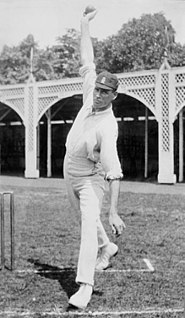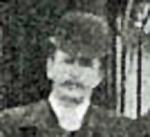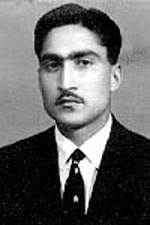Related Research Articles

The Kenya national cricket team represents the Republic of Kenya in international cricket. Kenya is an associate member of the International Cricket Council (ICC) which has Twenty20 International (T20I) status after the ICC granted T20I status to all of their members.

Sydney Francis Barnes was an English professional cricketer who is regarded as one of the greatest ever bowlers. He was right-handed and bowled at a pace that varied from medium to fast-medium with the ability to make the ball both swing and break from off or leg. In Test cricket, Barnes played for England in 27 matches from 1901 to 1914, taking 189 wickets at 16.43, one of the lowest Test bowling averages ever achieved. In 1911–12, he helped England to win the Ashes when he took 34 wickets in the series against Australia. In 1913–14, his final Test series, he took a world series record 49 wickets against South Africa.

Glamorgan County Cricket Club is one of eighteen first-class county clubs within the domestic cricket structure of England and Wales. It represents the historic county of Glamorgan. Founded in 1888, Glamorgan held minor status at first and was a prominent member of the early Minor Counties Championship before the First World War. In 1921, the club joined the County Championship and the team was elevated to first-class status, subsequently playing in every top-level domestic cricket competition in England and Wales.

Arnold James Fothergill was an English professional cricketer who played first-class cricket for Somerset County Cricket Club and the MCC in a career which spanned from 1870 until 1892. A left-arm fast-medium pace bowler, he appeared for England in two Test matches in 1889.

Roy Kilner was an English professional cricketer who played nine Test matches for England between 1924 and 1926. An all-rounder, he played for Yorkshire County Cricket Club between 1911 and 1927. In all first-class matches, he scored 14,707 runs at an average of 30.01 and took 1,003 wickets at an average of 18.45. Kilner scored 1,000 runs in a season ten times and took 100 wickets in a season five times. On four occasions, he completed the double: scoring 1,000 runs and taking 100 wickets in the same season, recognised as a sign of a quality all-rounder.

Marcus James North is a former Australian first-class cricketer who played 21 Test matches and two One Day Internationals (ODIs) for the Australian national side.

Munir Malik was a Pakistani cricketer who played three Tests for Pakistan between 1959 and 1962. A right-arm fast-medium bowler, he took nine wickets in Test cricket at an average of 39.77, including a five-wicket haul against England. During his first-class career, he took 197 wickets at the average of 21.75.
Lungile Edgar Bosman is a former South African international cricketer. He was a top order right-handed batsman and occasional right-arm medium pace bowler. He played domestic cricket for Dolphins, and appeared for South Africa in both One Day Internationals and Twenty20 Internationals. He scored the first century in the Standard Bank Pro20 Series in the 2004–05 season.

The Philadelphian cricket team was a team that represented Philadelphia, Pennsylvania, in first-class cricket between 1878 and 1913. Even with the United States having played the first ever international cricket match against Canada in 1844, the sport began a slow decline in the U.S. This decline was furthered by the rise in popularity of baseball. In Philadelphia, however, the sport remained very popular and from the end of the 19th century until the outbreak of World War I, the city produced a first class team that rivaled many others in the world. The team was composed of players from the four chief cricket clubs in Philadelphia–Germantown, Merion, Belmont, and Philadelphia. Players from smaller clubs, such as Tioga and Moorestown, and local colleges, such as Haverford and Penn, also played for the Philadelphians. Over its 35 years, the team played in 88 first-class cricket matches. Of those, 29 were won, 45 were lost, 13 were drawn and one game was abandoned before completion.

Christopher John Llewellyn Rogers is a former Australian cricketer who played for Australian national team. Rogers is a left-handed opening batsman. He spent ten years playing for Western Australia, before moving to play for Victoria in 2008. He has played county cricket in England for the past ten years for five first-class teams Derbyshire, Leicestershire, Northamptonshire, Middlesex and Somerset. Rogers holds the record for most half centuries in consecutive innings.

Alfonso Clive Thomas is a South African former professional cricketer. He is a right arm fast-medium bowler and a big hitting lower-order batsman. Playing in South African domestic cricket for North West, Northerns, the Titans, the Lions, and the Dolphins, Thomas has also played English county cricket for Warwickshire and Somerset, Indian Premier League matches for the Pune Warriors, and in Australian domestic cricket for the Adelaide Strikers and the Perth Scorchers. In June 2014, Thomas took four wickets in four balls in a County Championship game against Sussex. He was a pioneer of death bowling in the early years of T20 cricket.
James Cobbett was an English professional cricketer who played first-class cricket from 1826 to 1841 for Middlesex, Surrey and Sheffield Cricket Club. Considered by many - according to The Cricketer and Wisden - to be "the finest allrounder of his day", Cobbett was a right-handed batsman, occasional wicket-keeper and right arm slow roundarm bowler.
George Millyard was an English professional cricketer who played first-class cricket from 1835 to 1842. He was a cousin of his Sussex colleagues Jem and William Broadbridge.
Edwin Napper was an English amateur cricketer who played first-class cricket from 1839 to 1862.
William Henry Caldecourt was an English professional cricketer who played first-class cricket from 1821 to 1844.
Bartholomew Good, known as Billy Good, was an English professional cricketer who played first-class cricket from 1831 to 1847.
Daniel Hayward was an English professional cricketer who played first-class cricket from 1832 to 1851. He was the father of Cambridge batsmen Thomas Hayward and Daniel Hayward junior; and the grandfather of Tom Hayward, the Surrey and England opener.
John Gude Wenman was an English professional cricketer who played first-class cricket from 1825 to 1838. He was a cousin of Ned Wenman. He played for Kent and made nine known appearances in first-class matches. He represented the Players in the Gentlemen v Players series and the South in the North v. South series.

Roelof Erasmus van der Merwe is a professional cricketer who has played internationally for both South Africa and the Netherlands, one of the few players to represent more than one international team. From Johannesburg, van der Merwe made his first-class and List A debuts for Northerns during the 2006–07 season, before moving into franchise cricket with Titans the following season. An all-rounder he bowls left-arm orthodox spin and is a right-handed middle-order batsman. He played ODI and Twenty20 International cricket for South Africa between 2009 and 2011, playing 13 times in each format. van der Merwe gained a Dutch passport in June 2015, and was selected in the Netherlands squad for the 2015 ICC World Twenty20 Qualifier.
Craig Alexander Young is an Irish cricketer. Young is a right-handed batsman who bowls right-arm medium pace. On 26 May 2013, Young made his first-class debut for Ireland against Scotland. He made his One Day International debut against Scotland in September 2014, taking 5 wickets for 45 runs. He made his Twenty20 International debut against Scotland on 18 June 2015.
References
- ↑ CricketArchive. Retrieved on 4 December 2008.
| This biographical article related to an English cricket person born in the 1800s is a stub. You can help Wikipedia by expanding it. |